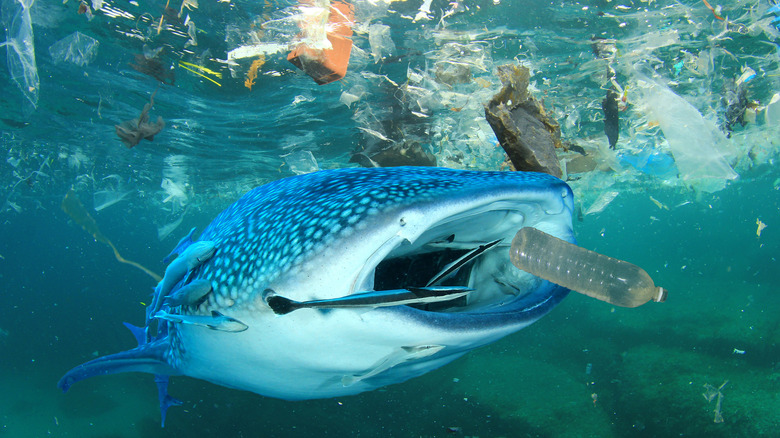The Largest Shark In The World Isn't Even A Carnivore
Whale sharks are the largest shark (and largest fish) in the world, but don't let their size fool you. These huge fish have been dubbed "gentle giants" due to their calm and slow nature. Whale sharks are massive, weighing an average of 11 tons and measuring around 40 feet (via World Wildlife Fund). They typically feed near the surface around the coasts and are easy to find thanks to their white spots, making them popular with snorkelers and divers.
Since whale sharks are filter feeders, it has been long thought that they primarily filter water to obtain krill, tiny shrimp-like crustaceans that serve as a food source for many birds, fish, and whales (via Britannica). New research, however, suggests that whale sharks only eat krill as a result of filter feeding for other food. According to the study, published in Ecology, krill acts as a secondary food source for whale sharks, with algae acting as their primary source of food.
Researchers investigated whale shark diets by studying their feces
Researchers in Australia were studying whale shark feces and skin samples when they realized that these gentle giants may be reliant on algae as a food source. According to Dr. Patti Virtue, a biological oceanographer at the University of Tasmania, "the poop did show that they were eating krill, but they're not metabolizing much of it" (via the Australian Institute of Marine Science).
It appears that rather than filter feeding for krill and getting some algae as a result, its actually the other way around. It seems that whale sharks are getting most of their nutrients from the algae. Not only that, but tissue analysis from the whale shark skin samples shows they have a fatty acid profile more consistent with omnivores rather than carnivores (via Science Alert). Researchers believe that whale sharks may have been carnivores as one point, but through evolution adapted to an omnivorous diet to take advantage of the algae they were already inhaling.
Plastics are polluting the whale shark's feeding grounds
While filter feeding tends to work out for the whale shark, it has become a more dangerous activity as of late. According to Science Alert, whale sharks follow surface currents to find large quantities of algae and krill that have been gathered together by the waves. These currents unfortunately also bring pollutants like plastic into the same areas. When whale sharks gulp up large quantities of food, they are also inhaling human trash. In fact, one study published in Cell revealed that microplastics in our oceans are hurting filter feeding animals, such as whale sharks, rays, and baleen whales.
The IUCN Red List currently defines whale sharks as an endangered species, and things might be getting worse for these giant fish. The whale shark population has seen a 63% decrease in the past 75 years, and its populations are still decreasing. While major threats to the whale shark currently including fishing and vessel strikes, significant unhealthy changes to their diets could also play a role in the decreasing number of whale sharks worldwide.


